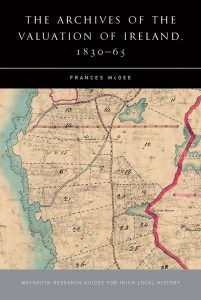Archivists are an austere and lofty bunch, forever struggling with the contradiction between preserving their beloved records and having to make them available to the grubby-fingered public. And utter impartiality is required – that collection of 1930s postcards has to be just as important as a set of medieval royal charters.
 So it is a rare and wonderful day, the archival equivalent of Stockholm Syndrome, when an archivist is captured by a set of records and devotes herself to understanding and making them intelligible. That seems to have happened to Frances McGee, former director of the National Archives of Ireland, and the result is her extraordinary The archives of the valuation of Ireland, 1830–65 (Four Courts Press, 2018).
So it is a rare and wonderful day, the archival equivalent of Stockholm Syndrome, when an archivist is captured by a set of records and devotes herself to understanding and making them intelligible. That seems to have happened to Frances McGee, former director of the National Archives of Ireland, and the result is her extraordinary The archives of the valuation of Ireland, 1830–65 (Four Courts Press, 2018).
More than any other set of Irish records, the manuscript maps and notebooks that predate the publication of the Primary Valuation are difficult to grasp in their entirety. Partly, this is because they can be very technical, concerned with producing a uniform property-tax base across the entire island under difficult and changing physical and legal conditions. Partly, it is down to the records having been held by different institutions. For researchers, there can seem to be a bewildering plethora of overlapping record-types.
 As in the parable of the blind men trying to describe an elephant by touch, we have until now only been able to understand parts of the collection. Frances McGee shows us the full magnificent beast.
As in the parable of the blind men trying to describe an elephant by touch, we have until now only been able to understand parts of the collection. Frances McGee shows us the full magnificent beast.
Parts of her book are painful but necessary, a systematic analysis of each of the class of notebooks produced at each stage of the different valuing processes. But the pain is well worth it. Finally it is possible to see how and why they all relate to each other.
The section on Valuation maps is a revelation. The notebooks were only one part of the valuing process – the field and office maps were absolutely central. Once NAI completes the conservation and digitization of its more than 12,000 valuation maps, there is no doubt they will revolutionise Irish local and family history before 1865.
The book comes to life when the author allows her enthusiasm for the documents’ worms-eye view of pre-Famine Ireland to shine through, quoting numerous examples: one valuator’s description of the state of a building in Ballina, Co. Mayo in 1841:
“This was used as a cholera hospital and in consequence could not since be let as a dwelling. Is now let to the hunting club for the huntsman and the offices as kennels”;
Muff, Donegal in 1834:
“a place of no trade and only two fairs in the year”.
The townland of Ballyrune in Limerick in 1849:
“All the tenants in this townland were ejected on 1 April 1849.; There is no part of the land at present occupied.”
My main criticism of the book is that it treats only the 30,000 items currently held by NAI, saying very little about records held elswhere. It also works on the unspoken assumption that all of these records are currently available to the public, which is far from the case. The treatment of the collection online at genealogy.nationalarchives.ie, the only current access for the grubby-fingered public, is a little too austere and lofty: “Some documents are searchable online for free …[at] census.nationalarchives.ie/search/vob/home.jsp“. Well, yes. Which ones?
If you’d like more, I’ll be speaking about the full Valuation Office archive (and channelling Frances McGee’s book) on Friday next at the Celtic Connections conference in Boston.
http://www.fourcourtspress.ie/books/2018/the-archives-of-the-valuation-of-ireland/
Very interesting. But still not clear how to access this volume from a distance …
Thanks
Marilee
That talk sounds really interesting. Any chance of you repeating it a little closer to home?
Nuala
Totally bummed that I can only hear the first hour of your presentation. I’m lecturing on PRONI during the second hour! See you on Friday.
He’s back!
Tenure and Field books which were passes on to the National many years ago were microfilmed. These are the books that are online. But there were others that were only handed over to the National Archives round 3 years ago. These were generally, the manuscript Tenure Books on which the published Griffith’s Valuation were based, as well as the most informative series of the Field Books and House Books of the early 1840s. These manuscripts can be ordered and perused in the National Archives, as they are not available in any other form. There is no catalogue for them so you have to get the reference codes from the Duty Archivist.
I will be at the Celtic Connections conference and can’t wait to hear you speak.
Thank you very much for your delightful and insightful article – and…you absolutely nailed it about those of us in the archiving, aka obsessive/compulsive preservers, arena – “Archivists are an austere and lofty bunch, forever struggling with the contradiction between preserving their beloved records and having to make them available to the grubby-fingered public.”
And we are looking forward to seeing you on Friday!
Chiseling a pinpoint of light through certain brick walls: “Once NAI completes the conservation and digitization of its more than 12,000 valuation maps, there is no doubt they will revolutionise Irish local and family history before 1865.”
And that will be a very glorious day when that happens!
Great News!
This material sounds so interesting. I am sorry I can’t attend the conference. I did last time and it–and you, of course–was great. I learned so much. Attended all three of your lectures.
Let the grubby-fingered public use Ancestry and like sites, they have no appreciation for preservation, or understanding archives.
Dang, John! I missed the Celtic Conference and a chance to hear you speak in my hometown (as consolation, though, I have to admit that I was in St. John’s and Harbour Grace, Newfoundland researching my Irish ancestors who eventually made their way to Boston). Do you have any other engagements scheduled in the US Northeast upcoming?